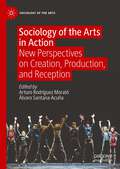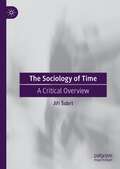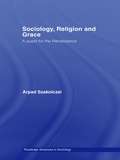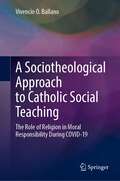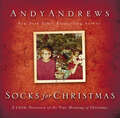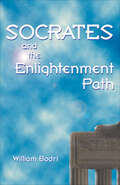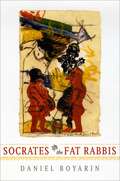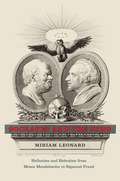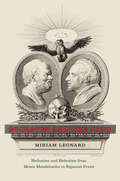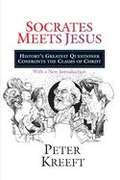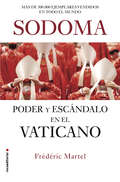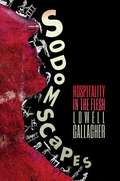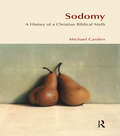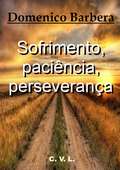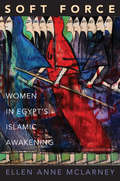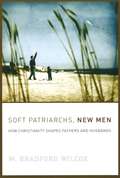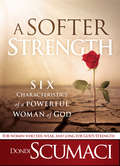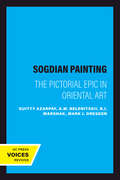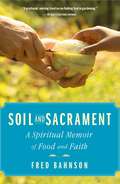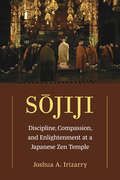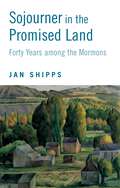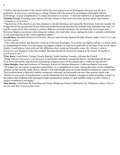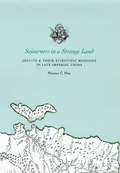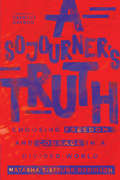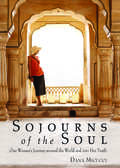- Table View
- List View
Sociology of the Arts in Action: New Perspectives on Creation, Production, and Reception (Sociology of the Arts)
by Arturo Rodríguez Morató Alvaro Santana-AcuñaThis edited collection carries out an extensive coverage of the sociology of arts’ most characteristic thematic areas (production, creation, the artwork, and reception) across an important range of artistic fields, from the most traditional to the more unusual. It makes an argument for the theoretical creativity and empirical expansion that characterizes the study of contemporary sociology of the arts. Such creativity is present in the increasingly predominant approach to a sociology of the arts in action, in all areas of inquiry within the discipline. The range of theoretical paradigms evoked is rich, analysing several of the most important theoretical frameworks currently handled in the discipline (Bourdieu, Becker, Peterson, ANT), and combining them with the works of many other influential contemporary specialists (De Nora, Hennion, Lamont, Menger and Born et al.). The book also establishes links to less known theoretical frameworks and some from different fields including economic sociology,microsociology, ethnomethodology, semiotics, and cultural history. The volume argues that Spanish-speaking scholars are now at the forefront of new developments in the field of the sociology of the arts, and is the first effort to gather research by these influential Spanish-language scholars in a single volume for an English-language audience.
The Sociology of Time: A Critical Overview
by Jiří ŠubrtIn a critical, comparative study of the sociological literature, this book explores the term “time,” and the various interconnections between time and a broad cluster of topics that create a conceptual labyrinth. Various understandings of time manifest themselves in the context of many individual social problems—there is no single vision in sociology of how to grasp time and address within social theory. This book, therefore, attempts to define an approach to the concept of time and its associated terms (duration, temporality, acceleration, compression, temporal structures, change, historical consciousness, and others). The volume is guided by a critical engagement with three main questions: a) the formation of human understanding of time; b) the functioning of temporal structures at different levels of social reality; c) the role and place of time in general sociological theory.
Sociology, Religion and Grace (Routledge Advances in Sociology)
by Arpad SzakolczaiThis book offers a sociological analysis of the Renaissance, focusing on the concept of grace, and the unity that exists between its various meanings: theological, anthropological (gift-giving, Mauss; and sociability, Simmel), and aesthetical (beauty and gracefulness). Since the seminal work of Max Weber rooted capitalism, and thus the modern world, in the Protestant ethic, interest in the Renaissance among social scientists has been minimal. However, this book argues that the heart of the European tradition lies in a series of renascences, going back to Minoan Crete and its rebirth in classical Greek civilisation, during an earlier global age. The Renaissance forged a novel unity between the Judaic-prophetic and Minoan-Athenian traditions, renewing grace in all its aspects and thus revitalising Europe. This attempt tragically failed and the modern world is the outcome of this explosion. All this has vital contemporary relevance, as the classical European tradition is still a unique source suggesting a way out of the spiralling logic of globalisation.
A Sociotheological Approach to Catholic Social Teaching: The Role of Religion in Moral Responsibility During COVID-19
by Vivencio O. BallanoThis book introduces Catholic social teaching (CST) and its teaching on the common good to the reader and applies them in the realm of public health to critically analyze the major global issues of COVID-19 that undermine public interest. It uses the sociotheological approach that combines the moral principles of CST and the holistic analysis of modern sociology and also utilizes the secondary literature as the main source of textual data. Specifically, it investigates the corporate moral irresponsibility and some unethical business practices of Big Pharma in the sale and distribution of its anti-COVID vaccines and medicines, the injustice in the inequitable global vaccine distribution, the weakening of the United States Congress’s legislative regulation against the pharmaceutical industry’s overpricing and profiteering, the inadequacy of the World Health Organization’s (WHO) law enforcement system against corruption, and the lack of social monitoring in the current public health surveillance system to safeguard the public good from corporate fraud and white-collar crime. This book highlights the contribution of sociology in providing the empirical foundation of CST’s moral analysis and in crafting appropriate Catholic social action during the pandemic. It is hoped that through this book, secular scholars, social scientists, religious leaders, moral theologians, religious educators, and Catholic lay leaders would be more appreciative of the sociotheological approach to understanding religion and COVID-19. “This book brings into dialogue two bodies of literature: documents of Catholic social teaching, and modern sociology and its core thinkers and texts...The author does especially well to describe how taking ‘the sociotheological turn’...will benefit the credibility and dissemination of Catholic social thought.”- Rev. Fr. Thomas Massaro, S.J., Professor of Moral Theology, Jesuit School of Theology, Santa Clara University, Berkeley, California.
Socks for Christmas: A Child's Discovery of the True Meaning of Christmas
by Andy AndrewsLooking for a thoughtful gift that will be cherished for many Christmases to come? Socks for Christmas is the little red book that has touched countless lives. In the late 1960s, New York Times bestselling author Andy Andrews thought he was having a very good Christmas… until he got socks from his Aunt Ruth--unarguably a very lousy gift. How could he know that those lousy socks would change Christmas and him forever!Socks for Christmas is great for all ages and will give your family an instant Christmas tradition. This timeless holiday book:Teaches lessons on gratitude, giving, and understanding others during the seasonInspires hearts and brings families togetherStirs nostalgia, tradition, and joy in any heart at Christmas timeSocks for Christmas is a:Safe gift for a boss, co-worker, or employeeThoughtful gift for a family member or loved oneA great option for gift exchangesWhether you read it yourself or listen to Andy on the CD (included with your purchase), Socks for Christmas is a great way to kick off the season.
Socrates and the Enlightenment Path
by William BodriThis enlightening exploration of Buddhism and Socratic philosophy reveals the deep connections between these two profound traditions of thought.The basis of Western thought and, indeed, our educational system can be attributed to the truth-seeking methods of Socrates. One of the Greek philosopher’s most enduring concepts, the importance of self-knowing, has been echoed throughout Western literature and has many reverberations within Eastern thought.William Bodri shows that Socrates had attained a spiritual stage called samadhi, satisfying the requirements specified in Buddhist systems of one who had attained enlightenment. Bodri points to the comparisons and contrasts between East and West, illuminating both Buddhist and Socratic thought. Using Socrates as an example, Bodri calls for the broadening of our Western ideas of learning to encompass spiritual knowing.
Socrates and the Fat Rabbis
by Daniel BoyarinWhat kind of literature is the Talmud? To answer this question, Daniel Boyarin looks to an unlikely source: the dialogues of Plato. In these ancient texts he finds similarities, both in their combination of various genres and topics and in their dialogic structure. But Boyarin goes beyond these structural similarities, arguing also for a cultural relationship.In Socrates and the Fat Rabbis, Boyarin suggests that both the Platonic and the talmudic dialogues are not dialogic at all. Using Michael Bakhtin’s notion of represented dialogue and real dialogism, Boyarin demonstrates, through multiple close readings, that the give-and-take in these texts is actually much closer to a monologue in spirit. At the same time, he shows that there is a dialogism in both texts on a deeper structural level between a voice of philosophical or religious dead seriousness and a voice from within that mocks that very high solemnity at the same time. Boyarin ultimately singles out Menippean satire as the most important genre through which to understand both the Talmud and Plato, emphasizing their seriocomic peculiarity.An innovative advancement in rabbinic studies, as well as a bold and controversial new way of reading Plato, Socrates and the Fat Rabbis makes a major contribution to scholarship on thought and culture of the ancient Mediterranean.
Socrates and the Jews: Hellenism and Hebraism from Moses Mendelssohn to Sigmund Freud
by Miriam Leonard"What has Athens to do with Jerusalem?" Asked by the early Christian Tertullian, the question was vigorously debated in the nineteenth century. While classics dominated the intellectual life of Europe, Christianity still prevailed and conflicts raged between the religious and the secular. Taking on the question of how the glories of the classical world could be reconciled with the Bible, Socrates and the Jews explains how Judaism played a vital role in defining modern philhellenism. Exploring the tension between Hebraism and Hellenism, Miriam Leonard gracefully probes the philosophical tradition behind the development of classical philology and considers how the conflict became a preoccupation for the leading thinkers of modernity, including Matthew Arnold, Moses Mendelssohn, Kant, Marx, Nietzsche, and Freud. For each, she shows how the contrast between classical and biblical traditions is central to writings about rationalism, political subjectivity, and progress. Illustrating how the encounter between Athens and Jerusalem became a lightning rod for intellectual concerns, this book is a sophisticated addition to the history of ideas.
Socrates and the Jews: Hellenism and Hebraism from Moses Mendelssohn to Sigmund Freud
by Miriam Leonard"What has Athens to do with Jerusalem?” Asked by the early Christian Tertullian, the question was vigorously debated in the nineteenth century. While classics dominated the intellectual life of Europe, Christianity still prevailed and conflicts raged between the religious and the secular. Taking on the question of how the glories of the classical world could be reconciled with the Bible, Socrates and the Jews explains how Judaism played a vital role in defining modern philhellenism.Exploring the tension between Hebraism and Hellenism, Miriam Leonard gracefully probes the philosophical tradition behind the development of classical philology and considers how the conflict became a preoccupation for the leading thinkers of modernity, including Matthew Arnold, Moses Mendelssohn, Kant, Marx, Nietzsche, and Freud. For each, she shows how the contrast between classical and biblical traditions is central to writings about rationalism, political subjectivity, and progress. Illustrating how the encounter between Athens and Jerusalem became a lightning rod for intellectual concerns, this book is a sophisticated addition to the history of ideas.
Socrates Meets Jesus: History's Greatest Questioner Confronts the Claims of Christ
by Peter KreeftWhat would happen if Socrates--yes, the Socrates of ancient Athens--suddenly showed up on the campus of a major university and enrolled in its divinity school?What would he think of human progress since his day?How would he react to our values? To our culture?And what would he think of Jesus?Peter Kreeft, Christian philosopher and longtime admirer of the historic Socrates, imagines the result. In this drama Socrates meets such fellow students as Bertha Broadmind, Thomas Keptic and Molly Mooney. Throughout, Kreeft weaves an intriguing web as he brings Socrates closer and closer to a meeting with Jesus. Here is a startling and provocative portrayal of reason in search of truth.In a new introduction to this revised edition, Kreeft also highlights the inspiration for this book and the key questions of truth and faith it addresses.
Sodoma: Poder y escándalo en el Vaticano
by Frédéric MartelSodoma expone la decadencia y la corrupción en el corazón del Vaticano y de la actual Iglesia católica. Es un libro con un claro mensaje al Vaticano de parte de todos los que anhelan una Iglesia inspirada en el Evangelio, una Iglesia para los pobres, los marginados y los desposeídos. Este brillante y perturbador trabajo, basado en cinco años de investigación rigurosa, incluye extensas entrevistas a los más altos cargos que ostentan el poder en el Vaticano.El libro revela la existencia de una camarilla gay en el Vaticano, en la que Frédéric Martel argumenta que sus orígenes vienen del papado de Pablo VI (1963 – 1978). Martel describe al Vaticano como «el mayor armario de la ciudad» y da pruebas de que un alto número de cardenales son homosexuales. Aun cuando estos mismos cardenales están entre la gente proponiendo decretos en contra del matrimonio homosexual y muchos otros temas relacionados con la moralidad sexual.Pero este libro también habla sobre corrupción en otras esferas del clero: el choque entre oficiales de la iglesia con regímenes fascistas que persiguen y torturan a gente inocente; turbios negocios inmobiliarios; la hipocresía al defender y proteger a curas pederastas; y, por encima de todo, la predominante cultura del clericalismo, a través del cual muchos escándalos son ignorados y dejados de lado. La crítica ha dicho...«La originalidad de su investigación es que establece la homosexualidad — una homosexualidad callada y mezclada de homofobia— como núcleo del sistema eclesiástico. [...] Es la llave que permite entender muchos de sus problemas.»El País «Un colosal ensayo fruto de cuatro años de investigación que revela la presencia mayoritaria de homosexuales en el clero, la jerarquía de la Iglesiacatólica y, sobre todo, en el Vaticano, hasta el punto de estructurar esa institución y de definirla.»El Mundo «Una bomba periodística que promete sacudir los cimientos de la Iglesia Católica y a la gran mayoría de sus representantes.»El Confidencial «Lo que era meramente anecdóticoadquiere por fin una visibilidad sociológica. Ya era hora.»Artículo de James Alison, uno de los sacerdotes entrevistados por Martel, en Jot Down «Cambiar la estructura es, honestamente, muy complejo. El papa no tiene realmente la capacidad para hacerlo solo.»Entrevista a Frédéric Martel a elDiario.es a través de EFE«No tengan miedo a su extensión porque estas páginas valen mucho la pena.»JNSP «Sexo, secretos y mentiras en el armario del Vaticano.»The Times «En Sodoma, Frédéric Martel describe un verdadero "sistema gay" en las altas esferas de la Iglesia. Su investigación será un hito.»Le Point
Sodomscapes: Hospitality in the Flesh
by Lowell GallagherSodomscapes presents a fresh approach to the story of Lot’s wife, as it’s been read across cultures and generations. In the process, it reinterprets foundational concepts of ethics, representation, and the body. While the sudden mutation of Lot’s wife in the flight from Sodom is often read to confirm our antiscopic bias, a rival tradition emphasizes the counterintuitive optics required to nurture sustainable habitations for life in view of its unforeseeable contingency.Whether in medieval exegesis, Russian avant-garde art, Renaissance painting, or today’s Dead Sea health care tourism industry, the repeated desire to reclaim Lot’s wife turns the cautionary emblem of the mutating woman into a figural laboratory for testing the ethical bounds of hospitality. Sodomscape—the book’s name for this gesture—revisits touchstone moments in the history of figural thinking and places them in conversation with key thinkers of hospitality. The book’s cumulative perspective identifies Lot’s wife as the resilient figure of vigilant dwelling, whose in-betweenness discloses counterintuitive ways of understanding what counts as a life amid divergent claims of being-with and being-for.
Sodomy: A History of a Christian Biblical Myth (BibleWorld)
by Michael CardenThe biblical narrative of Sodom and Gomorrah has served as an archetypal story of divine antipathy towards same sex love and desire. 'Sodomy' offers a study of the reception of this story in Christian and Jewish traditions from antiquity to the Reformation. The book argues that the homophobic interpretation of Sodom and Gomorrah is a Christian invention which emerged in the first few centuries of the Christian era. The Jewish tradition - in which Sodom and Gomorrah are associated primarily with inhospitality, xenophobia and abuse of the poor - presents a very different picture. The book will be of interest to students and scholars seeking a fresh perspective on biblical approaches to sexuality.
Sofrimento, paciência, perseverança
by Domenico Barbera JANDER TEMÍSTOCLES DE OLIVEIRAOs três substantivos: sofrimento, paciência e perseverança são apresentados não em caráter geral, mas aquele experimentado pelos profetas da Sagrada Escritura ao longo de suas vidas e ministérios. Obra essencial para compreensão do texto bíblico e de aplicação prática no dia-a-dia.
Soft Force: Women in Egypt's Islamic Awakening
by Ellen Anne MclarneyIn the decades leading up to the Arab Spring in 2011, when Hosni Mubarak's authoritarian regime was swept from power in Egypt, Muslim women took a leading role in developing a robust Islamist presence in the country's public sphere. Soft Force examines the writings and activism of these women--including scholars, preachers, journalists, critics, actors, and public intellectuals--who envisioned an Islamic awakening in which women's rights and the family, equality, and emancipation were at the center.Challenging Western conceptions of Muslim women as being oppressed by Islam, Ellen McLarney shows how women used "soft force"--a women's jihad characterized by nonviolent protest--to oppose secular dictatorship and articulate a public sphere that was both Islamic and democratic. McLarney draws on memoirs, political essays, sermons, newspaper articles, and other writings to explore how these women imagined the home and the family as sites of the free practice of religion in a climate where Islamists were under siege by the secular state. While they seem to reinforce women's traditional roles in a male-dominated society, these Islamist writers also reoriented Islamist politics in domains coded as feminine, putting women at the very forefront in imagining an Islamic polity.Bold and insightful, Soft Force transforms our understanding of women's rights, women's liberation, and women's equality in Egypt's Islamic revival.
Soft Patriarchs, New Men: How Christianity Shapes Fathers and Husbands (Morality and Society Series)
by W. Bradford Wilcox Brad WilcoxIn the wake of dramatic, recent changes in American family life, evangelical and mainline Protestant churches took markedly different positions on family change. This work explains why these two traditions responded so differently to family change and then goes on to explore how the stances of evangelical and mainline Protestant churches toward marriage and parenting influenced the husbands and fathers that fill their pews. According to W. Bradford Wilcox, the divergent family ideologies of evangelical and mainline churches do not translate into large differences in family behavior between evangelical and mainline Protestant men who are married with children. Mainline Protestant men, he contends, are "new men" who take a more egalitarian approach to the division of household labor than their conservative peers and a more involved approach to parenting than men with no religious affiliation. Evangelical Protestant men, meanwhile, are "soft patriarchs"—not as authoritarian as some would expect, and given to being more emotional and dedicated to their wives and children than both their mainline and secular counterparts. Thus, Wilcox argues that religion domesticates men in ways that make them more responsive to the aspirations and needs of their immediate families.
A Softer Strength: The Six Characteristics of a Powerful Woman of God
by Dondi ScumaciGod made you uniquely who you are on purpose! In A Softer Strength, Dondi Scumaci shows you how to live a life that is motivating, inspiring, and that brings you into a full realization of God&’s purpose and plan for you. She highlights six approaches that will increase your inherent talents and develop the spiritual strength that leads to victory: •Softening your inner dialogue •Empowering and equipping yourself for success •Increasing your emotional intelligence •Asking for what you want •Being clear in thought and deed •Letting love reignite your world You were designed for success in all of your roles. Your work as a mother, mentor, professional, leader, or volunteer should be challenging and inspiring. Start now; your opportunities are waiting!
Sogdian Painting: The Pictorial Epic in Oriental Art
by Guitty AzarpayThis title is part of UC Press's Voices Revived program, which commemorates University of California Press’s mission to seek out and cultivate the brightest minds and give them voice, reach, and impact. Drawing on a backlist dating to 1893, Voices Revived makes high-quality, peer-reviewed scholarship accessible once again using print-on-demand technology. This title was originally published in 1981.This title is part of UC Press's Voices Revived program, which commemorates University of California Press’s mission to seek out and cultivate the brightest minds and give them voice, reach, and impact. Drawing on a backlist dating to 1893, Voices Revived</DIV
Soil and Sacrament
by Fred BahnsonPart spiritual quest, part agricultural travelogue, this moving and profound exploration of the joy and solace found in returning to the garden is inspiring and beautiful.After he graduated from Duke Divinity School, Fred Bahnson underwent an agrarian conversion. Trading the pulpit for the plough, Bahnson helped start a community garden in Cedar Grove, North Carolina--a town struggling under an unspoken racial divide. As Anathoth Community Garden slowly cultivates a new future as a progressive multi-racial society, Bahnson is likewise transformed from shy and self-effacing to a charismatic leader. His time at Anathoth becomes the impetus for a road trip spent visiting different faith-based agrarian groups, one for each season--from a community of Roman Catholic monks who pursue a life of contemplation while harvesting rare mushrooms on a Southern plantation, to a Jewish organic farm in the Berkshires, where he and other young people learn the agrarian arts of ancient Israel right in Connecticut. Recently appointed director of Wake Forest University School of Divinity's pioneering Food, Faith, and Religious Leadership Initiative, Bahnson is the perfect guide on this lyrical and inspiring journey. Through his travels across the country and into his own past, Bahnson comes to see "how our yearning for real food is inextricably bound up in our spiritual desire to be fed" and discovers how rituals of cultivation can become a powerful source of community and purpose.
Sojiji: Discipline, Compassion, and Enlightenment at a Japanese Zen Temple (Michigan Monograph Series in Japanese Studies #94)
by Joshua A. IrizarrySōjiji is one of the two head temples of Sōtō Zen, the largest sect of Japanese Buddhism. The temple is steeped in centuries of culture and tradition, but it is very much rooted in the present and future, performing functions and catering to needs that reflect the changing demographic, social, and religious landscapes of contemporary Japan. Based on more than fifteen years of fieldwork, interviews, and archival research, Sōjiji: Discipline, Compassion, and Enlightenment at a Japanese Zen Temple immerses the reader in the lives and experiences of the different groups that comprise Sōjiji's contemporary religious community. Through clear and accessible prose, ethnographically-grounded analysis, and emotionally compelling stories, the reader will explore the rich pastiche of daily life and ritual activity at a major Japanese Zen temple in institutional, historical, and social context through the lived practices of its community of clergy, practitioners, parishioners, and visitors.
Sojourner in the Promised Land: Forty Years among the Mormons
by Jan ShippsInfused with Jan Shipps’s lively curiosity, scholarly rigor, and contagious fascination with a significant subculture, Sojourner in the Promised Land presents a distinctive parallel history in which Shipps surrounds her professional writings about the Latter-day Saints with an ongoing personal description of her encounters with them. By combining a portrait of the dynamic evolution of contemporary Mormonism with absorbing intellectual autobiography, Shipps illuminates the Mormons and at the same time shares with the reader what it has been like to be on the outside of a culture that remains both familiar and strange.
Sojourners and Strangers: The Doctrine of the Church (Foundations of Evangelical Theology Series)
by Gregg R. Allison John S. FeinbergWhat is a church? This can be a difficult question to answer and Christians have offered a variety of perspectives. Gregg Allison explores and synthesizes all that Scripture affirms about the new covenant people of God, capturing a full picture of the biblical church. <p><p>He covers the topics of the church’s identity and characteristics; its growth through purity, unity, and discipline; its offices and leadership structures; its ordinances of baptism and the Lord’s Supper; and its ministries. Here is a rich approach to ecclesiology consisting of sustained doctrinal reflection and wise, practical application.
Sojourners in a Strange Land: Jesuits & Their Scientific Missions in Late Imperial China
by Florence C. HsiaThough Jesuits assumed a variety of roles as missionaries in late imperial China, their most memorable guise was that of scientific expert, whose maps, clocks, astrolabes, and armillaries reportedly astonished the Chinese. But the icon of the missionary-scientist is itself a complex myth. Masterfully correcting the standard story of China Jesuits as simple conduits for Western science, Florence C. Hsia shows how these missionary-scientists remade themselves as they negotiated the place of the profane sciences in a religious enterprise.Sojourners in a Strange Land develops a genealogy of Jesuit conceptions of scientific life within the Chinese mission field from the sixteenth through eighteenth centuries. Analyzing the printed record of their endeavors in natural philosophy and mathematics, Hsia identifies three models of the missionary man of science by their genres of writing: mission history, travelogue, and academic collection. Drawing on the history of early modern Europe’s scientific, religious, and print culture, she uses the elaboration and reception of these scientific personae to construct the first collective biography of the Jesuit missionary-scientist’s many incarnations in late imperial China.
A Sojourner's Truth: Choosing Freedom and Courage in a Divided World
by Patricia Raybon Natasha Sistrunk RobinsonA Sojourner's Truth
Sojourns of the Soul
by Dana MicucciSojourns of the Soul differs from other inspirational travel books by providing a rare mix of in-depth wisdom and literary insights from the holistic view of one experienced female traveler. Dana Micucci gives a compelling account of her growing spiritual illumination through visits to some of the most sacred places on earth. Her lively, engaging narrative takes us to seven sites in all: the Australian outback, Angkor in Cambodia, the Valley of the Kings in Egypt, Lhasa in Tibet, Chichen Itza in the Yucatan; the Monastery of Christ in the Desert in New Mexico, and Machu Picchu in Peru.Micucci links each visit with the awakening of a particular chakra- the chakras being the seven energy centers of the body associated in Hinduism with progressive enlightenment. In the afterword, she reflects on how her experiences continue to shape her life after resuming her career as a journalist in New York City: she finds she is more tolerant, can engage in daily activities with more heart-centered awareness, and can sustain states of joy and gratitude for longer periods of time.The book will be a page turner for readers who yearn for long-delayed adventure, with the added benefit that it is not just a journey log but more of a seeker's manual; travel is simply the vehicle. Readers will find that they don't have to travel to far-flung places for the spiritual inspiration available in their everyday lives. As Micucci says, "Each day brings new remembrances of our divinity, of the Divine presence in all beings, and of our eternal connection to each other. I am so grateful to be here NOW . . . with you."
